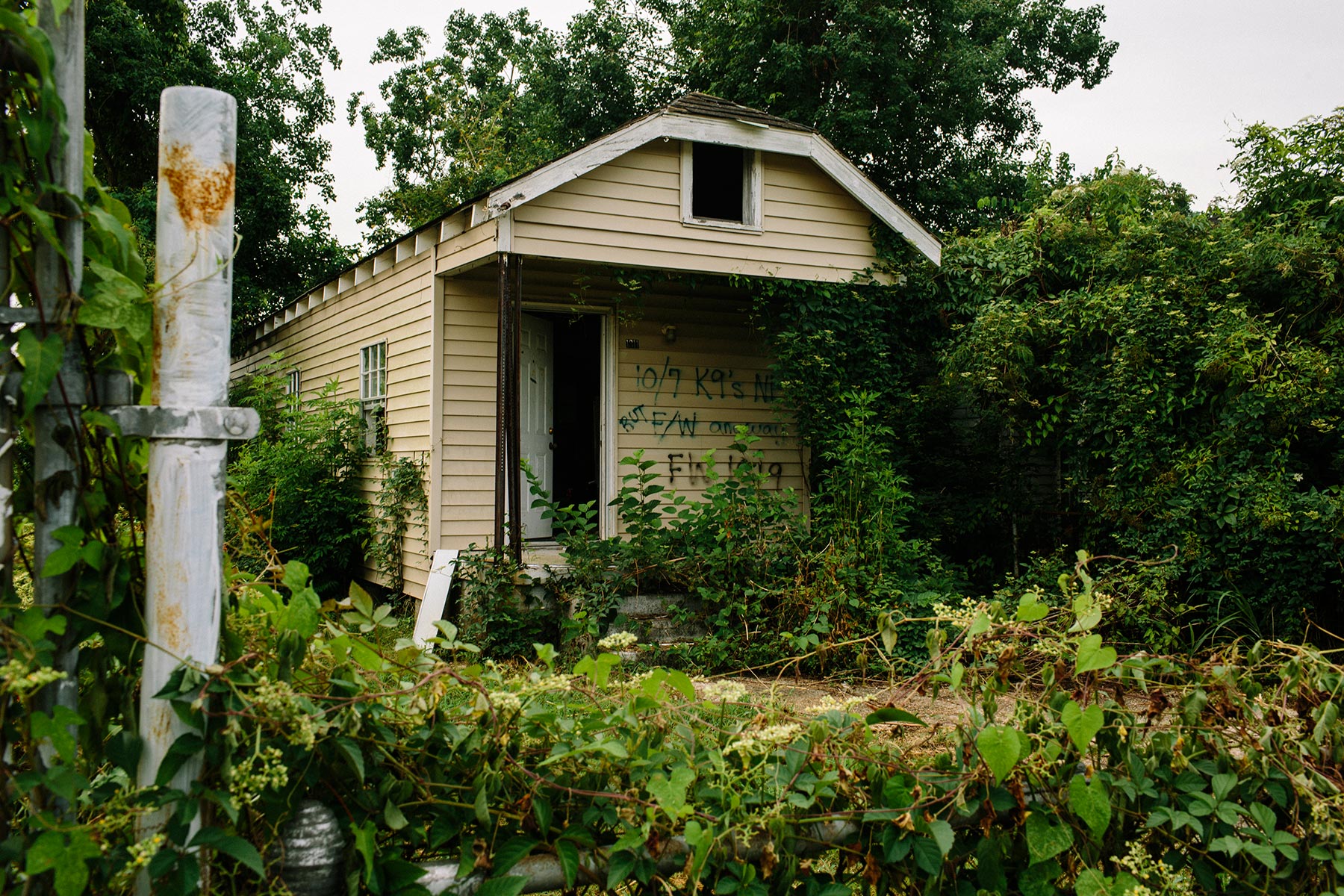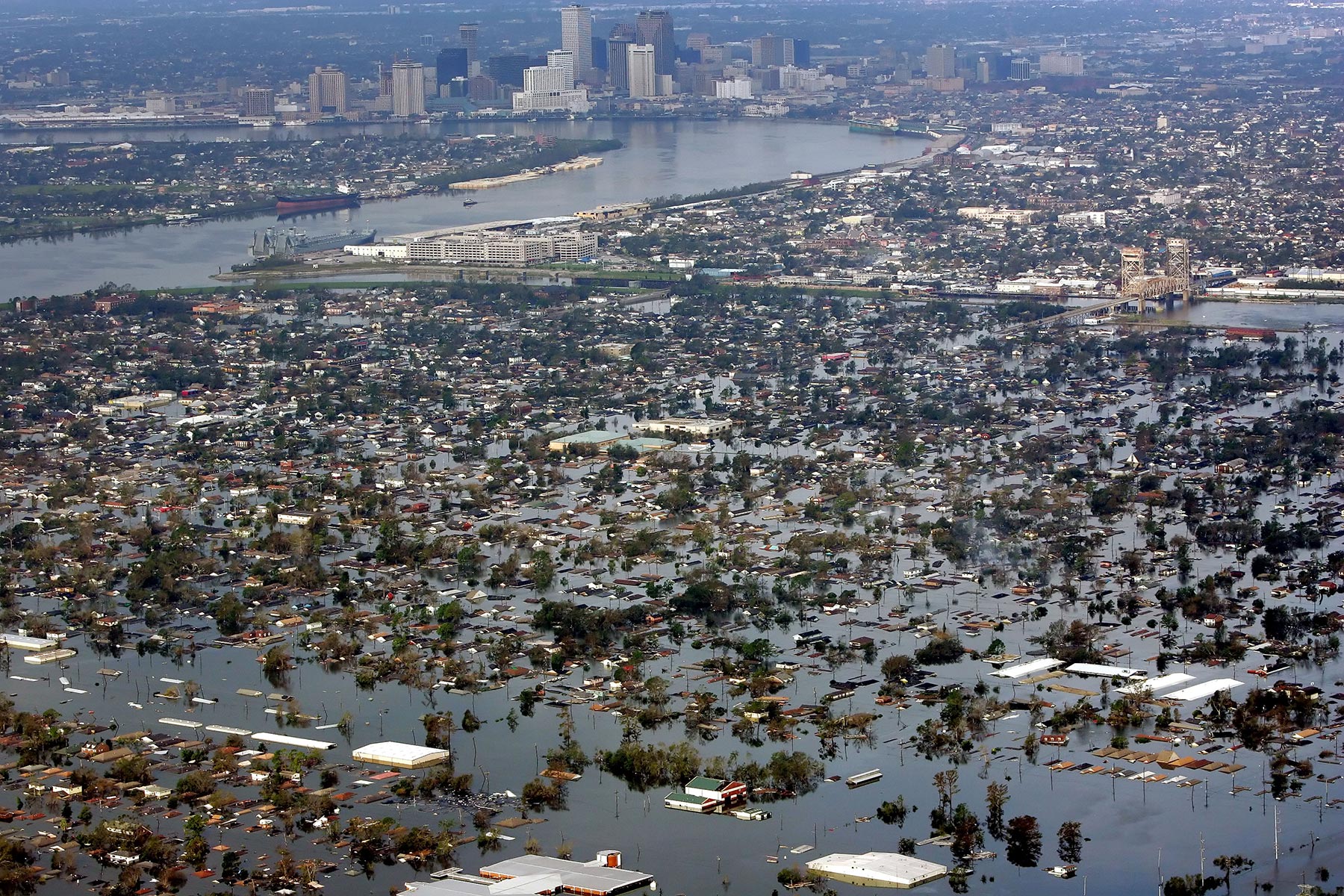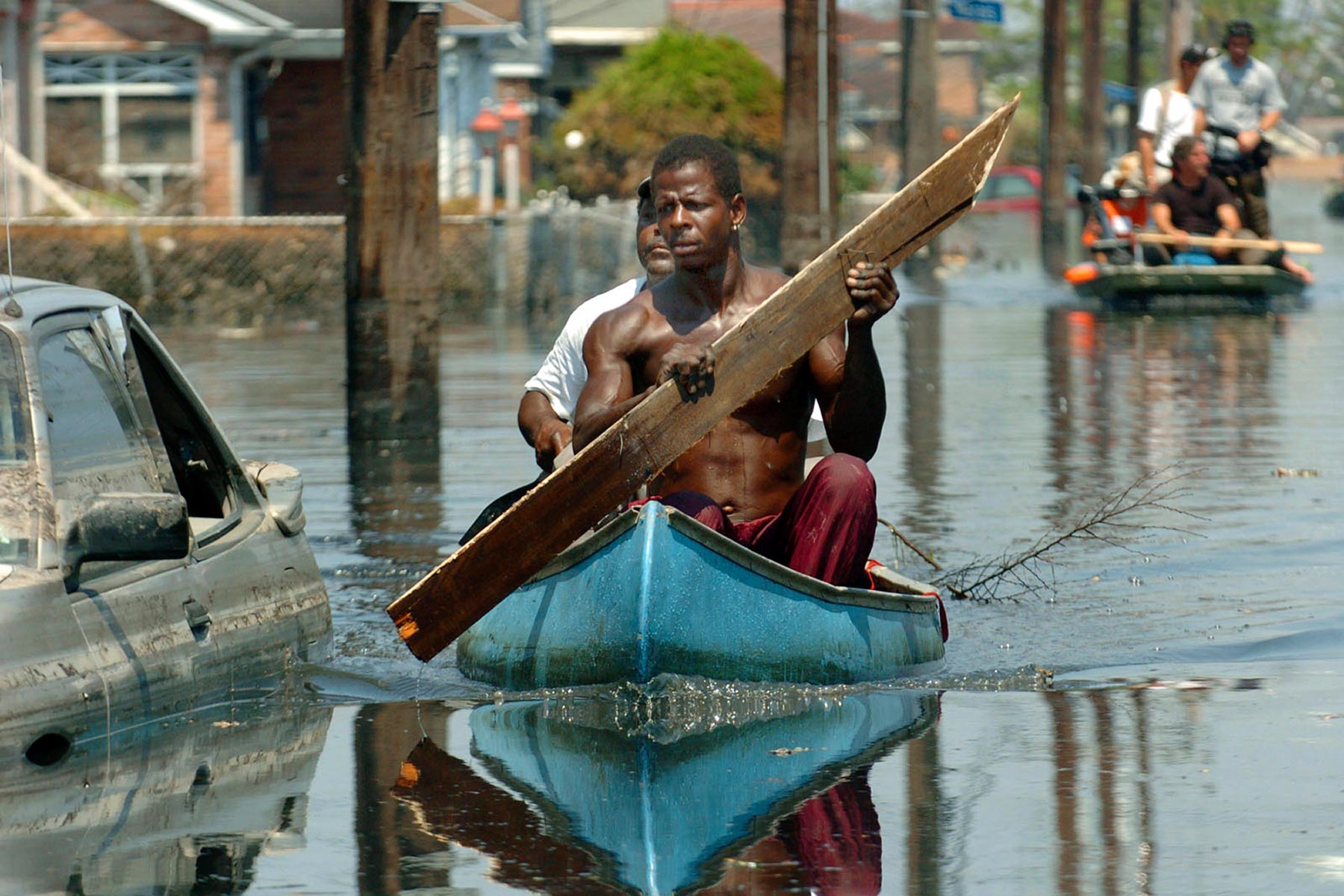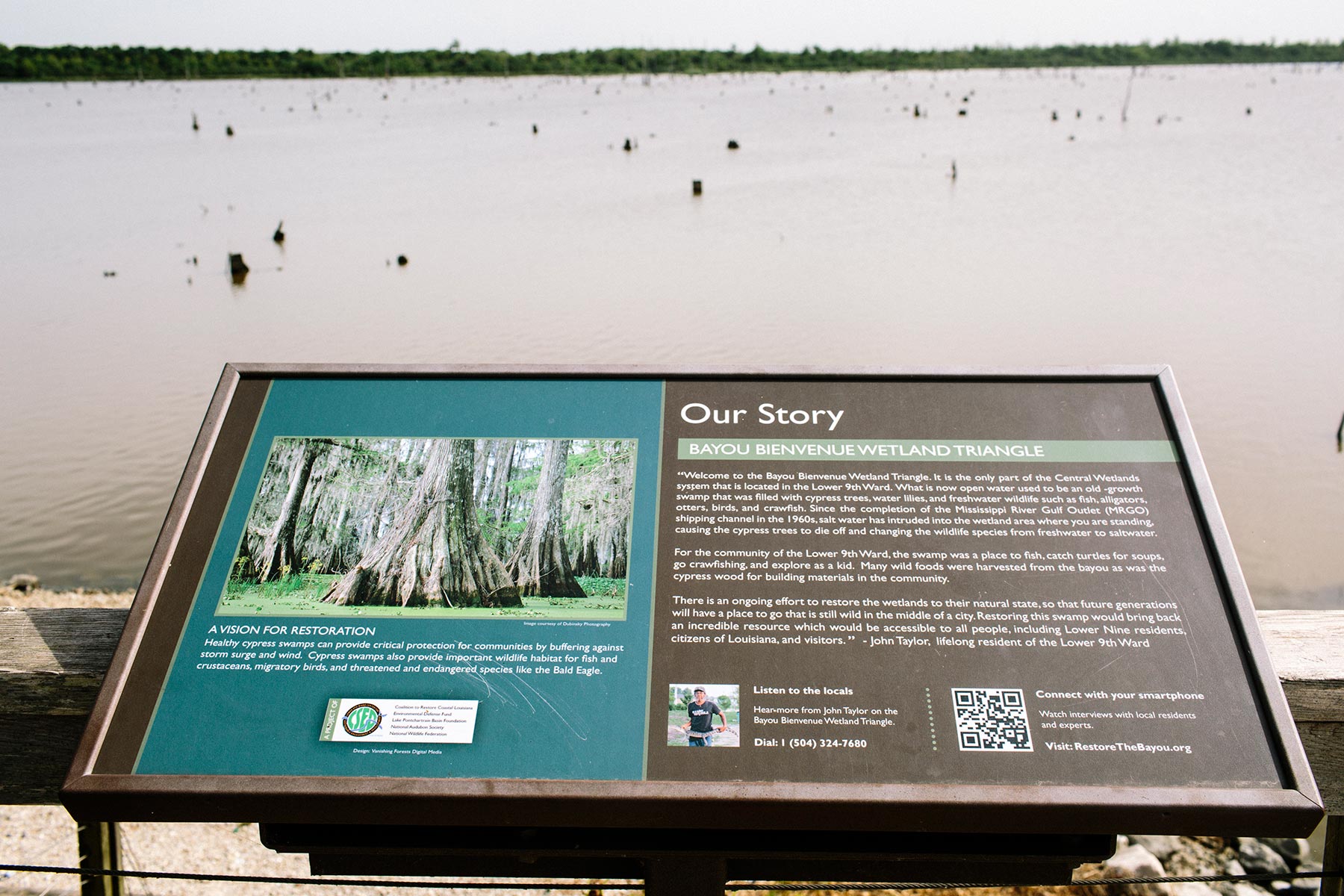
A lower ninth ward story
A walking tour of what still stands
John Taylor started his walks a few months after the storm, when he first came back to the Lower Ninth Ward.
In the beginning, it was just to see what happened to his neighbors. Who had stayed and who returned, and who didn’t and why. It helped him track the property damage, houses pulled off their foundations by floodwaters, then deposited blocks away.
Ten years later, Taylor is still walking. Each Sunday, just after dawn, he gets up to secure the perimeters of his island. His uniform is a pair of faded jeans, a polo shirt, a camouflage baseball cap with a deer on it, and most importantly, a beautiful walking stick fashioned from a twisted local willow branch, a piece of post-Katrina driftwood.
He figures his tour is about six miles, “a good little walk,’’ Taylor says. He starts up on an earth and concrete river levee that overlooks the mighty Mississippi. His view from the Lower Ninth Ward gives him a southwestern glance at the city skyline. But because of the C-shaped river bend at the heart of New Orleans, the source of the ‘Crescent City’ moniker, it looks as if the downtown has turned its back on this often documented — and often forgotten — neighborhood.
Taylor’s walk is a different kind of documentation, a weekly check-in where he casts an eye on the waters and people and streets he’s known since childhood, when he was one of 11 siblings, growing up in a house at the corner of Tonti and Choctaw streets.
Taylor, 67, lost his sister, his family’s home and his means of income to Katrina. He spent a few months with his nephew in California until residents were allowed back in the lower Ninth. The years have given him time for some reflection.
“I thought it was a horrible thing at the beginning,’’ he says. “But it became a unique experience, you know, that nothing is permanent.’’
Technically the Lower Ninth is one water boundary short of a true island. It’s framed by the Mississippi River, an industrial shipping canal, and a dying bayou. The last line of demarcation is the National Guard’s Jackson Barracks, which is also where Orleans Parish, which encompasses New Orleans, changes over to St. Bernard Parish. The difference between the majority black population in the Lower Ninth and the more white, rural St. Bernardians feels profound enough to serve as a kind of fourth island border.
As a child, Taylor easily slipped past that line of demarcation.
“I went everywhere I wanted to because I was a light skinned black guy with red hair,’’ he says, “so I didn't see much trouble like a dark skinned black guy with nappy nappy black hair.”
Taylor stares out at the river, which is inching its way up the levee, swollen from rainwater runoff up in Northern Louisiana and Texas. Massive oil and coal barges float by, accompanied by buzzing tugboats, saddled up to the enormous metal hulls like pilot fish to a whale. The gravel path atop the levee heads to an industrial corridor with a pier. On the right a row of abandoned warehouses sits covered in rust and graffiti.
Eventually the levee hits the brick wall separating the Lower Ninth from the National Guard Barracks. Enormous trees draped in the haunting Southern canvas of Spanish moss shade the collegiate looking military campus. The American flag is at half-staff.
When Taylor first came back to the Lower Ninth, he was overwhelmed.
In a neighborhood that was already three feet below sea-level in some places, 12 feet of floodwaters settled there for weeks. The ward was the site of dramatic rescues of locals stranded on rooftops. Taylor was the only person still living in his family’s home when the storm hit.
“It was sort of a good thing my mother and father died before Katrina,'' he says. "So they didn't have to come back and see everything they worked for gone, you know.”
The Taylor home was inundated by floodwaters and finished off by another house that floated from three blocks away, ramming into the middle of the structure.Taylor wasn’t home. He’d evacuated with a brother-in-law and nephew a day and a half before Katrina hit. The trio wound up in a high school doubling as a displacement center just north of Baton Rouge. While stranded, Taylor says he got a phone call from a New Orleans hospital, where his sister was having an operation before the storm.
“When the power went out, no power, no respirator. She ended up suffocating.”
His sister’s home, across the street from his parents’ house, was also destroyed by floodwaters. The four trucks he used to scavenge for scrap metal around New Orleans were completely waterlogged.
Taylor walks, he says, because it helps him think.
"It's a sort of meditation thing" he says. "I have to figure out everything I do, so I walk and figure it out.”
Eventually Taylor hits St. Claude Avenue, which starts at the French Quarter, and runs along the river as it heads east into St. Bernard Parish. It’s the dividing line of sorts in the Lower Ninth, from a slightly wealthier middle class area to one of the poorer parts of the city.
Crossing St. Claude also coincides with a drop in elevation, making it more flood-prone. For the most part, the Holy Cross side of St. Claude Avenue came back. Houses that were damaged got fixed up, or rebuilt, and a lot of new people moved in.
“It's whites, but it's different whites,” says Taylor, as he spots a young dirty blonde out walking her dog. He’s referring to the droves of newcomers who arrived to volunteer, and later take advantage of exciting local culture and relatively cheap rents compared to New York City and Los Angeles. Thanks to this migration, and the return of pre-Katrina families, more than half of the 72 neighborhoods in New Orleans are close to their pre-storm populations.
The next major landmark, Claiborne Avenue, is in sight as Taylor continues to walk north, towards Bayou Bienvenue. This is where elevation really drops off, and things went historically wrong for Taylor’s neighbors. “You had to go around the houses in the street, houses floated from 3 or 4 blocks away, in different spots. They wasn't where they was when I left.”
Every second or third lot on the other side of Claiborne is either empty or blighted. Abandoned homes are being devoured by nature, layers of vines strangling doors and open windows, deconstructing one-story shotguns. The front steps to houses stand idle in the grass, elevating to nothing. Many abandoned properties display faded X-codes, a kind of archive left by Katrina rescue teams as they searched for dead bodies. Streets are still lined with massive potholes lying in wait to damage even the most sturdy cars.
Ten years on, the Lower Ninth North of Claiborne still looks apocalyptic. Taylor says even so, he still never questioned whether or not he’d move back as soon as he could. “If I didn't have a dime I wouldn't starve to death here. Cause if I was walking down the street and people thought I was hungry, me myself, they would feed me.”
A few blocks ahead, Taylor sees an old friend.
Eli Slaughter, 84, is on a vintage blue riding mower cutting his church’s lawn, sweating in the growing heat of this early-July morning. Taylor gives Slaughter the local standard greeting, “alright!” and then the ribbing begins.
“Come on man, you can't go no faster than that? You can't go no faster than that, Slaughter? You don't want to do it anyhow. How you doing? How's everything?”
Slaughter rolls a slow tortoise-like glance at Taylor and replies, “I ain't complaining.”
Socially, Taylor displays an agility for both Southern formality — he asks Slaughter about his family, “and your madame?” — as well as down-home teasing.
“You ain't still making babies, huh?”
Taylor waves his wood cane at Slaughter, his friend, and continues his walk.
“Glad to see you, Mr. Slaughter, take care now.’’
A few blocks later he runs into another old acquaintance.
“That's one of my babies there,'' he says, referring to a beautiful cypress tree towards the back of an abandoned lot. "That tree there's got to be 100 years old. See the base, the size of it. It's not going away.”
The address of the long gone house, 1329, is still spray-painted in green on the sidewalk. Taylor says the neighborhood, built on a former swamp, was full of Cypress trees as a kid. In fact he says this area was a regular Southern ‘Eden’, “cypress, pecans, fig trees, we had fruits and mulberry trees and stuff like that you know. Back yard gardens, everybody had gardens.”
It’s not that nature isn’t still thriving in the Lower Ninth. It is, a kind of wildness that is suffocating whole blocks. Some animals are new arrivals, like coyotes, never seen here before Katrina. The problem is fewer people are around to maintain this area. The Data Center, a New Orleans research institution, calculated that the Lower Ninth’s population went from around 14,000 pre-storm residents, to around 3,000 residents now, one of the most dramatic census drops in the city.
The city’s Redevelopment Authority mows some of the vacant lots, sold by residents who decided not to come back to the neighborhood. But other city services are harder to come by.
Taylor says it’s become a little lawless out here. Response times to 911 calls in New Orleans often take longer than 20 seconds, the national standard, and the understaffed police department has to pick and choose cases based on urgency. Taylor says people who don’t even live in the Lower Ninth Ward come over to take advantage of its isolation, dumping garbage on streets, and stealing things like drain grates, to sell as scrap metal.
After passing blocks where few if any residents returned, Taylor stops to greet 62-year-old Earnest Dejean. Standing tall with a broom, Dejean looks like a kind of Lower Ninth homesteader. His house is one of a handful of identical brick bungalows, and his populated block teems with cars, lawnmowers and barbecue grills.
Dejean says he was displaced to Texas for eight years, and just recently got some money to help restore his home. He likes the peace and quiet of his neighborhood.
“Only thing going on here is the train pass every now and then,'' he says. "Other than that, we don't hear nothin’ back in here.”
Taylor gives Dejean a gripping handshake to say goodbye: “Don't get too hot now.”
Delery dead-ends at Florida Avenue, and beyond that, Bayou Bienvenue begins, and this long walk is about to hit its halfway point. Taylor crosses a railroad track and hops a concrete wall. Taylor looks out at a brackish bay as a young grey heron swoops by. When Taylor was a middle schooler in the late 50s and early 60s, Bayou Bienvenue was his classroom.
Looking out at his favorite swamp, he remembers cypress trees that once were so dense that “you could almost walk across it.”
Taylor couldn’t get local kids his age to join him catching turtles and trapping nutria, so he started hanging out with people he met back in the trees. He recalls the names: “Dollar Bill, Mr. Turner, Mr. Steve.” These were mostly Cajun trappers and farmers who lived and worked in the swamp. Taylor says they let him hang around because he could keep up with the wildlife. “They liked me because I was almost as good as they was," he says.
Bayou Bienvenue has gone from a forest to an open bay in a matter of decades.One of the main culprits isthe Mississippi River Gulf Outlet. Built in 1965 by the Army Corps of Engineers, this navigation shortcut to the Gulf of Mexico was originally 500 feet wide and 72 miles long. It enabled a pathway for storms like Betsy and Katrina to blow farther north,dumping salt water deep into the bayou and offsetting the brackish balance that cypress trees thrive on. Those trees are mere stumps now.
”I'm sorta pissed because it had to be Katrina for them to notice this,'' he says. "If they don't notice this in ‘66, and pump that damn saltwater out, then every one of these trees would still be alive.”
Walking along a levee separating the bayou from the Lower Ninth, Taylor reverts to his younger self, and starts finding and catching things. There’s a disoriented female turtle, trying to lay her eggs in the same spot she always has. “When they repaired this after Katrina they put these rocks here, and there was soil here. She don't know what to do.” He picks her up, the turtle gets scared and pees on him, and he laughs it off, tossing her back into the water so she can find a better spot. Next Taylor spots a marsh rabbit, “that's the sweet eating rabbit,” he says. Behind some tall grass, roseate spoonbills try to stay hidden, but their electric pink plumage burns through the landscape, and they fly towards the local sewage treatment plant.
Taylor not only spots the animals, he talks to them. He coaxes a blue runner snake that has recoiled at the sight of him: “Go ahead baby, run … just run.” “Oh she's a nervous little son of a gun.” He’s got a range of sounds he makes too, like the black skimmer that glides low across the bayou scooping up bugs with its unique beak. And then there’s Taylor’s favorite bayou buddy, ‘Big Boy,’ a seven-foot alligator that likes to sunbathe back near a water pumping station. Taylor mimics Big Boy’s mating call, noting how “the bottom of his neck hunks up like a bullfrog.”
Taylor stops at a wooden platform put up by a local coalition of environmental groups. It’s meant to draw tourists and locals alike to see the degradation of Bayou Bienvenue. One of the “good experience” outcomes of Katrina for Taylor is the renewed interest in his swamp by environmentalists, and policymakers. There’s a $50 billion coastal restoration plan that seeks to repair Louisiana’s coast, and with it, hundreds of miles of swamp, the state’s natural defense system against storms. Taylor’s also gotten a job with a local nonprofit as a naturalist and tour guide, showing groups the bayou, and explaining why it matters. “I never thought I would be that important to be telling people about these wetlands.”

Scroll for more


Hopping another concrete partition Taylor heads across a dirt road and begins to follow a long flood wall that hugs the local industrial shipping canal. The original concrete and steel barrier here was short enough to look over, and jammed down into an earthen levee. Early on the morning of Aug. 29, 2005, with the canal swollen with Katrina storm surge, water began to topple over, and eventually two sections of this wall gave out, flooding the Lower Ninth Ward.
The post-Katrina wall is around 15 feet of concrete and it looks shiny and new. Knowing many people drowned on the other side, it also has the feel of a kind of cold, nameless memorial. With none of the debris — mattresses, air conditioners and cars — that lined this area for years in sight, the history here feels wiped clean. Taylor points to small cylindrical carvings in the new wall.
"That's a plug, if the water comes up and the pressure of the levee get ready to be compromised,'' he says. "All these little plugs pop out and the water comes through slowly.” The Army Corps of Engineers has spent around $14.5 billion to shore up the levee systems protecting New Orleans since Katrina. The promise is these new walls will protect the city for at least the next 100 years, but Taylor isn’t buying it. “What you know is gonna happen tomorrow, how the hell you gonna tell me what's gonna happen 100 years from now.”
It’s not that he doesn’t believe in engineering, just that he will always place his money on Mother Nature doing the unexpected. Taylor believes in climate change, and believes repairing his swamp will do more than any man-made wall to protect his community.
“Motherland has to stand,” he says.
What lies on the other side of this wall is not the same neighborhood that was there pre-Katrina. Taylor says there were five schools before the storm. Currently there’s one, and another in construction. There were three fire stations, now one, there’s one small grocery store that’s popped up with mostly dry goods, and a few gas stations. Taylor says for a neighborhood that had one of the highest rates of homeownership in the city, around 50 percent, and a population that stuck together for generations, the Lower Ninth deserves more attention from City Hall.
“They didn't even give back what we already had.”
Taylor has seen neighborhoods on the other side of the industrial canal build up since Katrina, including a new streetcar line, fixed roads, and new grocery stores. But on his end of the city it’s been a harder sell. Many people still have to take three buses, or head to St. Bernard Parish to shop at the Dollar Store or a full grocery.
Still, the Lower Ninth is lucky to exist. It once was part of a potential post-Katrina reconstruction plan that would have turned parts of six local neighborhoods into green spaces, areas for floodwaters to go during future storms. As the 10th anniversary of the storm arrives, a flood of road crews has arrived, finally paving over massive pot holes.
Taylor jumps one last concrete barrier, and heads under a graffitied tunnel underpass, back to the lush green Mississippi River levee. He points his cane at a beautiful crepe myrtle tree that is in full bloom with purple flowers, and gives an “alright,” to a young father on a skateboard, his son keeping up on a toy scooter. The last landmark on the walk is the enormous brick Holy Cross Catholic school campus, abandoned since Katrina. It sits in haunting disrepair, lined with razor wire. A local developer bought the building, and proposed condominiums. Some of the neighborhood rose up in opposition and derailed the original proposal, at least for now. But Taylor says he’s less worried about historic preservation and more interested in utilitarian needs. As one of the areas most devastated by Katrina, it’s time for the Lower Ninth to get a bigger piece of the investment that came after the storm.
“It needs to be developed, and stop being an eyesore,'' he says. "Maybe we can get a supermarket.”
On Aug. 30, the day after Hurricane Katrina is commemorated for the 10th time, the cameras and spotlights will disappear, and New Orleans will get back to the business of figuring out what kind of city it wants to be. Record tourism, and increased development around the city is expected as it nears its tricentennial in 2018. But will that trickle down to John Taylor and his Lower Ninth Ward island?
He’d like to see his neighborhood advance, but it’s not simply about seeing money and investment. “I had a thousand dollars in my pocket during Katrina and didn't have no damn way to spend it,'' he says. "So money's not all the time good.”
Taylor wants his swamp restored, and for his community to be a bigger part of the conversation about the future of the city. But he says as long as he can walk, fish, and come hell or high water, live right here, he’ll be OK. “This is our home, we gonna come back here, I don't care how long it take us to get back here, we're going to get back.”














